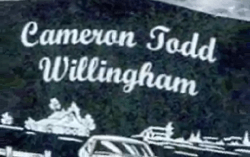Helen Zhang at Mediaite points out the sudden interest in the Texas death penalty case of Cameron Todd Willingham was prompted by a ginormous, 16,000-word article by the New Yorker magazine. The story is long — but it’s hard to stop reading it:
The fire moved quickly through the house, a one-story wood-frame structure in a working-class neighborhood of Corsicana, in northeast Texas. Flames spread along the walls, bursting through doorways, blistering paint and tiles and furniture. Smoke pressed against the ceiling, then banked downward, seeping into each room and through crevices in the windows, staining the morning sky.
Buffie Barbee, who was eleven years old and lived two houses down, was playing in her back yard when she smelled the smoke. She ran inside and told her mother, Diane, and they hurried up the street; that’s when they saw the smoldering house and Cameron Todd Willingham standing on the front porch, wearing only a pair of jeans, his chest blackened with soot, his hair and eyelids singed. He was screaming, “My babies are burning up!” His children—Karmon and Kameron, who were one-year-old twin girls, and two-year-old Amber—were trapped inside.
Related: How to spark readers’ interest and tell a hell of a story they won’t forget
 Here’s a valuable lesson for newspapers trying to give readers a reason to fork out the cost of a subscription. One reason why the New Yorker story made such an impact is its length. We’re used to the inverted pyramid and short, snarky blog posts. It’s refreshing when an article like this comes along that simply tells a story — a sequential series of events, as my pal Brian Chasnoff puts it. Reporter David Grann never even wrote a nut graph summarizing up high what the story was about. He simply told a story. And readers responded.
Here’s a valuable lesson for newspapers trying to give readers a reason to fork out the cost of a subscription. One reason why the New Yorker story made such an impact is its length. We’re used to the inverted pyramid and short, snarky blog posts. It’s refreshing when an article like this comes along that simply tells a story — a sequential series of events, as my pal Brian Chasnoff puts it. Reporter David Grann never even wrote a nut graph summarizing up high what the story was about. He simply told a story. And readers responded.



